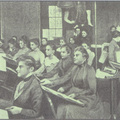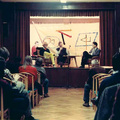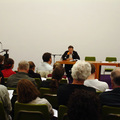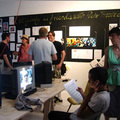DOCUMENTA XI
8 June - 15 September 2002
Kassel
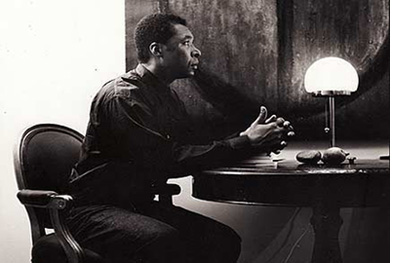 With his team of six co-curators from six different countries, artistic director Okwui Enwezor, the first not to have come from Europe, demonstrated an open-minded and truly international approach to the world for Documenta11. As envisaged in the original concept they invited artists to Kassel from countries that had never been represented there before, to make a unified international experience of the documenta as an exhibition of world art in a stage of global post-colonialism.
With his team of six co-curators from six different countries, artistic director Okwui Enwezor, the first not to have come from Europe, demonstrated an open-minded and truly international approach to the world for Documenta11. As envisaged in the original concept they invited artists to Kassel from countries that had never been represented there before, to make a unified international experience of the documenta as an exhibition of world art in a stage of global post-colonialism.
In terms of its content, time-scale and geographical dimensions Documenta11 was significantly broader in scope than any of its predecessors had been. Enwezor took the imbalance out of the art experience by holding the documenta in five different locations around the world. The exhibition at Kassel was the fifth of these 'platforms', as they were called; the other platforms that had preceded it represented venues for lectures and discussions that actively explored contemporary art-specific, political and social issues from a critical perspective. In this context the final exhibition platform supplemented and provided a reflection of the discursive platforms without in any way representing a merely illustrative approach to the theoretical discourse. The interplay between the different platforms demonstrated that aesthetic experience is an intellectual activity reliant on knowledge and the ability to discern. This notwithstanding, many of the artworks on show still proved accessible even without in-depth background knowledge through intuitive or reasoned observation – for example, Georges Adéagbo's assemblage L'explorateur et les explorateurs devant l'histoire de l'exploration…! Le théâtre du monde. The artist displayed images, signs, texts and other found material that related directly to the venue and the occasion, so creating a form for open encyclopaedic knowledge that questioned prevalent Western European dominated learning.
The result of this global and discursive analytical concept was a new record. 650,000 visitors came to appraise around 450 artworks on a surface area of 13,000 square metres at the largest documenta ever. The documenta was divided into parts that were shown at the Fridericianum, the Kulturbahnhof, the Orangerie and the Karlsaue, as it had been before. In addition, the Binding brewery was also added to these venues.
The question Enwezor posed behind the global orientation of the exhibition, "how contemporary art in all its different forms can continue to develop in a dialectic relationship to the entirety of global culture", was answered cautiously in the end. Taking into account the current political, technological and ideological conflicts, developments and mixtures, it proved an extremely "difficult and sensitive" undertaking. Consequently, in the end Enwezor left the public unclear about "contemporary art's prospects and its position in working on interpretational models for the different aspects of today's ideational worlds", although delivering a quantity of material for reflecting on the theme. Decisive was the taboo-break associated with the exhibition. Enwezor cast doubt on the claim to primacy of Western culture by shifting, even inverting, the centres of development and the references.
Artistic Director:
Okwui Enwezor
***
CRITICAL RESPONSE
1. Paul O'Neill: Curatorial Turn. From Practice to Discourse. esp. the section of Biennial Culture and the Culture of Curation
2. Dieter Lesage: Art, capitalism and resistance
...
Documenta11 as a discourse on resistance
If in recent years there has been a place where commitment in the arts seemed to be back, if it had ever disappeared at all, then that was the eleventh Documenta. From the start, Documenta11 seemed determined to give voice to underglobal despair and otherglobal critique. Okwui Enwezor, the first African artistic director of the manifestation, considered ‘Ground Zero’ as a symbol of resistance, albeit understood as resistance against western hegemony. According to Enwezor, many different discourses provided elements to elaborate this resistance in peaceful terms. Documenta11 was eager to produce interactions between reflection and artistic practice. Therefore it departed from the home-loving, traditional exhibition concept. Enwezor, assisted by six co-curators, organised Documenta into five so-called ‘Platforms’. Before the opening of the exhibition, at several locations around Kassel on June 8th 2002, there were four conferences in other parts of the world, dealing with the central themes, conferences that would end up later in as many publications. Platform1 (‘Democracy Unrealized’) took place in the Akademie der Künste in Vienna and the Haus der Kulturen der Welt in Berlin. Platform2 (‘Experiments with Truth: Transitional Justice and The Process of Truth and Reconciliation’) was organized in the India Habitat Centre in New Delhi. Platform3 (‘Créolité and Creolization’) was a workshop on the West-Indian island of Saint Lucia. Platform 4 (‘Under Siege: Four African Cities – Freetown, Johannesburg, Kinshasa, Lagos’) took place in the Nigerian megalopolis of Lagos. This unfolding of the Documenta on different platforms was clearly meant to delocalize Documenta somewhat, in order to increase its commitment with global issues and break with the occidento-centrism of the arts world.
At the same time, a microphysics of the delocalisations performed by the different Platforms in the latest Documenta edition shows that Documenta11 only partially succeeded in the promised deconstruction of occidento-centrism. The workshop on the island of Saint Lucia took place in the Hyatt Regency, a luxurious Spa & Beach resort, while the conference in the former Nigerian capital of Lagos was organized in the very challenging environment of the local Goethe Institut. In both cases, dislocation will not have been a very confronting experience. A workshop on creolisation at a luxurious beach resort does not seem the ideal context to legitimise the hypothesis of discourse as resistance. Despite all the standard hotel rhetoric which would have us believe that Hyatt hotels — in the design of the lobby and the guest rooms — engage in a dialogue with local culture, a Hyatt hotel is not the most appropriate location to reflect on creolisation. According to the meticulous record of the conference in its subsequent publication, none of the artists or intellectuals present seemed to have noticed the absurdity of the situation, at least not on the record. Or still. During one of the broad discussions on ‘créolité’ and ‘creolisation’, there is a rare moment of disillusionment, when Nobel Prize winner Derek Walcott, who was somehow an honorary guest of the conference, remarked that, during dinner, he had a strange experience:
“When I talk Creole to the waiters and waitresses in this hotel, they don’t answer me in Creole, because they think it’s not a proper means of social communication. I can see it in them; I speak to them and ask for something in Creole, and they answer me in English. I am trying to communicate in my own country, in pleasant conversation, using their language. But they don’t speak it. This is not a rule of the hotel. So we have to ask, why does that happen? Obviously, they believe that Creole is an inappropriate language for this hotel. They think it’s something inferior to the hotel, which is frightening, but understandable”
For Derek Walcott, this hotel anecdote subsequently gives rise to a direct indictment against another crucial choice of the Documenta workshop organisatioon and his verdict is harsh:
“[...] all of us who write polemically or for whatever reason about the language, do not do it in the language that we are trying to defend, in a way. So we don’t write, or we are not talking Creole now. We are talking English and French. We are speaking what used to be called an imperial language. Our discussion here is not in the language that we are talking about. So we have to ask ourselves this shattering question: where is the créolité in this conference without Creole?”
When one speaks of ‘the choice’ of Documenta, one will evidently be commenting in the first place on the selection of artists. But if one puts this arts manifestation in a political context, as Enwezor did, then one is allowed to test the cultural affair and to judge Documenta also on its non-aesthetic choices. Even then one asks oneself what kind of courage was needed to withdraw with a select group of people in a luxurious hotel on a Carribean island during a cold German winter week. Not only the exclusive location, but also the secluded character of the workshop contrasted strongly with the omnipresent rhetoric of ‘meeting’ and ‘confrontation’. An expansion of the concept of responsibility inevitably leads to these kinds of questions. The worked up rhetoric of dislocation, diaspora and deterritorialisation also challenges a critical observer to have a close look at the spaces that are being occupied in these operations. And then the dry verdict of the catalogue says: “ Hyatt Regency, Saint Lucia”. Or: Documenta moved to no man’s land. Behind the post-colonial paradigm we discover a transatlantic pleasure trip — arts business as usual.
In the Documenta11 exhibition catalogue, Ute Meta Bauer rightly addresses the critique that said that Documenta should take place in Kassel, but her description of the locations of the different platforms as ‘the relevant sites’ for the discourse that was being held there should be disavowed as rhetorical if one takes into account the specificity of each location. Documenta11 did n0t really invest the places where it went to during its first four Platforms on non-western continents, but managed each time to find a comforting local western context. While the principled choice for a mutual articulation of reflection and artistic practice can very well be defended, one has to recognize that the consequences of the theoretical choices of Documenta11 had not been thought through until the capillary ends of its organizing body. The discourse on resistance that Documenta11 was striving for did not result in a type of organization that matched its discursive counter-thoughts. And it did not help that Documenta11, despite all its nods towards anti-globalisation movements, occasionally preferred to settle down in the kind of reunion locations that world leaders also prefer when they hold their summits. In 1976, G7 met in the Hyatt Dorado Beach Resort and Country Club on another Caribbean island, Puerto Rico, a favorite holiday destination of almost all American presidents since Eisenhower.
This critique of Documenta11 differs radically from the critique that said that Documenta11 was too much discourse. The predictable grumbling by Jan Hoet, artistic director of Documenta IX, could give the impression that what was at stake with this Documenta was the classical conflict between theory and practice, between concept and form, between word and image, between reflection and emotion, between ratio and intuition — and that the curators of this exhibition had chosen theory, concept, word, reflection, ratio above practice, form, image, emotion, intuition. The conflict, however, that really characterised this Documenta, was not a conflict between theory and practice, but between resistance and resignation. The discourse of Documenta11 was not just any kind of discourse, it was a discourse on resistance. Not only were there many contributions to the four Platforms dealing with resistance that preceded the exhibition, the essays in the exhibition catalogue also reflected mainly on the potentialities of the arts as resistance strategy. Unsurprisingly, one of the most frequently cited books in those essays was Empire by Antonio Negri and Michael Hardt.
But even here there was a gap between the discourse and the practice of the organizers. Anyone who takes Empire seriously knows that it is a communist manifesto. The authors resist any kind of representative politics as the organizing principle of society. The global multitude is capable, they believe, of organizing itself. That is not a small claim. But what to think then of the fact that four out of seven Documenta11 curators were quoting Empire with the utmost approval? Why did we not see anything like panic in the arts scene as it had to witness this communist putsch? And why, on the other hand, did our communist curators not put an end to all forms of fetishism in a scene that is perverted by speculation, a scene that is endlessly complicit when it comes to the financial capitalism that controls much of the flows that characterize Empire? Why did the apparent production of knowledge of Empire — and Documenta11 was, according to Enwezor, all about the production of knowledge — why did this production of knowledge not give rise to a reflection on the place of Documenta itself within the Imperial organigram, as a global interface between artists and gallerists, collectors, curators and museums worlwide — an interface whose function consists in organizing the global flows of artists, art works and capital? And the question then is whether Documenta11 succeeded in generating a regime of flows that could be qualified as anti-Imperial. The definition of Documenta itself in the jargon of Empire should allow us to discover whether Documenta11 was merely flirting with philosophical hype, or that its curatorial team were very serious about the anti-Imperial critique of its representative majority’s favorite book. The intellectual credibility of Documenta11 then depends on the political principles that determined the organisation of the flows I mentioned.
Some of the flows I have been describing give rise to the suspicion that Empire was mainly valued by the Documenta team for its theoretical hipness factor. The authors cannot help it that their book became a phenomenon. But one can judge the users on the seriousness of their use. And one can seriously doubt this seriousness. In the Documenta11 catalogue, from time to time, the word ‘multitude’ is ceremoniously quoted, but ‘the multitude’ is nothing to do ceremoniously about. The concept figures, as one knows, in Negri’s and Hardt’s radical critique of representative democracy. But this theoretical context does not seem to have bothered the Documenta11 curators. Documenta remains an initiative of representative democracy, with all the ceremonies that entails. As ceremoniously as its anti-representative multitudinarian rhetoric, the Documenta11 catalogue’s preface was signed by Georg Lewandowski, mayor of Kassel.
Therefore, the problem with Documenta11 was certainly not that it was ‘too political’, as some have argued. The problem with Documenta11 was that it was not political enough. The decision to situate an arts manifestation resolutely within the world, as the catalogue’s visual intro made clear, not without pathos, was a strong one. But the discourse on this decision was evasive. It avoided the further choices that would have been the logical consequences of this first choice. And thus it happened that the critique of capitalism you could find here and there in the catalogue essays was soon to be replaced by praise for post-colonialism. Once again, the problematic of globalisation was culturalized, even when Empire, the Documenta11 curators’ cult book, was very sharp about the shortcomings of post-colonial theory. Again, this was no problem for the curators, who were having fun mixing Negri and Bhabha. And so one has an odd impression when reading many of the texts in the catalogue and some interventions on the different platforms. Many things that are said there are theoretically incoherent, but nevertheless a virtuoso metissage of theoretical concepts and approaches. One could even risk the hypothesis that the kind of theory that in general is produced in the margins of the arts industry is a kind of academic creole, a language in which concepts from very different intellectual traditions are mixed. Academics, then, thank their legitimacy for the artistic community to their mimicry of artistic recipes. One could call many of the theoreticians that entertain the discourse parts of arts manifestations TJ’s — theory jockeys. Paradoxically, their academic creole was never as lively as when, in the Hyatt Regency Spa & Beach Resort on Saint Lucia, the participants in the Documenta workshop came to the conclusion that creole was almost dead. At the penultimate ‘Open Session’, Charity Scribner improvised in an inimitable academic-creole:
“[...] in a way this Platform is performing a kind of requiem for Creole or, perhaps, creating the space for a reproduction of Creole, maybe even a kind of christening, a rechristening of Creole. But if this is, then, a work of memory that we are doing here for something that is perhaps fading away, my question is how is this work of memory something that can engage a collective? What I’m trying to get at is where the term ‘class’ might fit into this larger discussion. [...] whether we need that term of class anymore if we go the Empire route, or if we are comfortable leaving that behind and talking about the ‘multitude’. This seems to be another of the many shifting terms that we can apply to creolization, hybridity: the multitude. If we really go that far, will class come along with it?”
In this seech by TJ Charity Scribner, discourse becomes a party game. “Hey guys, do we do ‘class’, or do we do ‘the multitude’?” (whereby it becomes perfectly clear that the TJ can operate as an MC, as a Master — or Mistress — of Ceremonies. Thinking of Wittgenstein, much could be said in favor of this meta-discourse, this discourse on discourse as a language game. Instead of criticizing the Documenta11 curators because their discourse was not very coherent theorteically, one might prefer to write an éloge de la créolité académique. Compared to the theoretical output of Documenta, the work of some artists in the exhibition seemed much more rigorous. It would seem, for instance, that Maria Eichhorn, who presented Maria Eichhorn Limited Company, understood Negri and Hardt far better than some of the Documenta TJ’s. Her work is the result of a cool analysis of the problematic of an art work in a period of its speculative merchandization, a theme that was almost never discussed on the first four Platforms of Documenta11.
One could defend another reading of Documenta11 that would show more empathy than the severe verdict of theoretical incoherence. This reading would proceed as follows: if the curators were conscious of these kind of ambiguities, then they were apparently not capable of solving them organizationally. Then they were able to supplement an event with a discourse, without the principles of that discourse being able to determine the organisation of the event. If we demand from the organisers of the event intellectual coherence — a coherence that in many places was missing — then we may deny the fact that a mega-manifestation like Documenta allows curators, as much as it allows artists, only to interfere in a context that was already set the moment they entered the scene. The organizers do not get a grip on the event and limit themselves to skirmishes in the margins. These skirmishes, which took the form of extra-territorial Platforms, seem to prefer the form of discourse. A possible explanation for all this discursive audacity, for all this communist daring during all those Platforms is that discourse is experienced as the site to which resistance must withdraw. Resistance, then, is experienced as something which, today, is only possible as discourse. If one experiences discourse already as a failure of resistance, then one might want to mask that failure by making the discourse stronger than is reasonable. Rhetorical political daring becomes the way to experience resistance even within discourse. In this sense, the discourse on ‘the multitude’ sometimes seems to be characterized by the pleasure to be able to put all power in the hands of the multitude, at least in discourse, even if, or precisely because in the world as we know it, things are much more complex.
.....
© www.maska.si



